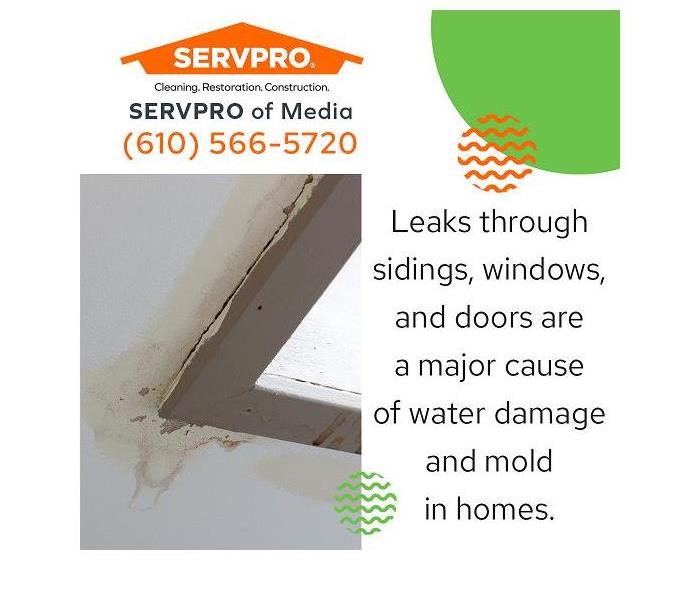Helping homebuyers avoid purchasing a home with an active mold infestation and mold damage
11/16/2022 (Permalink)
Blog Summary: When purchasing a home, homebuyers will want to make sure that the house does not have a mold problem that will require mold remediation services. SERVPRO® of Media is sharing a mold inspection checklist to help people identify and avoid mold-infested homes.
The experts at SERVPRO of Media are dedicated to providing dependable water damage restoration and mold remediation services for Newtown Square, PA, clients, including homebuyers who have purchased a house that needs mold remediation.
When and where to inspect for mold
Before ever making an offer on a home, go over the property with a mold checklist in hand to avoid assuming a problem that nobody wants to have, especially a new homeowner. A spot check on both outside and inside the home may reveal evidence of mold. Recommended equipment includes an LED headlamp for hands-free inspection, nitrile gloves, protective eyewear, and a mask. Document the inspection with images and video with a smartphone.
Phase one: Start on the outside of the home.
Begin the inspection before ever entering the home. Outside evidence of mold growth may indicate the presence of mold on the inside of the house.
Step #1: Examine the roof and gutter system for damage and signs of leaks.
Step #2: Check sidings, windows, and doors for damage. Leaks through siding, windows, and doors are a major cause of water damage and mold in homes.
Step #3: Look for cracks in the foundation and moisture in the crawl spaces.
Phase two: Inspect the interior of the home.
Step #1: Do a sniff test.
- A musty, mildewy, earthy smell is a strong indication of moisture and mold issues.
Step #2: Check ceilings, walls, and windows.
- Are there any brown, green, or black stains on ceilings, or especially on exterior walls?
- Are there any discolorations, warping, or swelling trim and baseboards around or below windows?
- Do exterior doors open and close smoothly?
Step #3: Give bathrooms a close look.
Bathrooms are typically the wettest rooms in a home and are vulnerable to mold from moisture and heat.
- Use the flashlight to expose any leaks or mold under the vanity. Feel supply line connections for leaks. Sniff for a mold odor. Test the floor for moisture, softness, or warping.
- Are stains on the caulking around toilets, showers, and bathtubs?
- Do the bathroom fixtures, walls, and ceilings have mold?
- Test all bathroom exhaust fans. Look for stains around the fan. A leaky roof stack can be a harbinger of extensive damage in the attic.
Step #4: Give the kitchen special attention.
- Use a flashlight to shed light on the area under the sinks. Check the walls, floor, drains, and supply lines for leaks. Press on the floor to see if it is dry and firm. Are there any signs of repairs?
- Examine the flooring under the refrigerator and dishwasher. Look for mold on the walls surrounding the refrigerator and on the appliance.
- Test the exhaust fan above the stove. Is the area around the fan and under the hood clean of grease and grime buildup? Is the stove light in good working order?
- Convert the stove light to an LED bulb, which burns much cooler and is just as bright.
Step #5: Shed some light on the attic areas.
- Start out with the sniff test.
- Check for stains or mold on the flooring, trusses, rafters, and sheathing.
- Mold thrives on paper, cardboard boxes, and clothing, which are often stored in the attic. Touch, smell, and visually inspect the contents of the attic for evidence of mold.
- Are all exhaust fans vented through the roof?
- Are there any signs of wild animals living in the attic?
Step #6: Visually inspect the HVAC system.
This system is complicated and technical. Moisture and electricity do not mix well, so be careful when scoping out the HVAC system.
- Open the access panel and perform the sniff test for mold.
- Use the flashlight to check for dust buildup, leaks in the condensate pan, and mold growing on or around the system. If the HVAC blower is in the attic, check the ceiling and walls above the system for signs of a leak. Look for any signs of rust on the unit.
- Check the cool air return covers for dirt, grime, and mold.
Phase three: Contact the mold professionals at SERVPRO® of Media.
If the decision is made to purchase the home, then congratulations! If mold is an issue, the mold removal professionals at SERVPRO of Media can handle any size mold issue and do it quickly, which is crucial when buying a new home or an investment property.
For more information about SERVPRO of Media’s mold remediation services, contact the office by email at office@SERVPROmedia.com or by phone at (610) 566-5720.





 24/7 Emergency Service
24/7 Emergency Service
